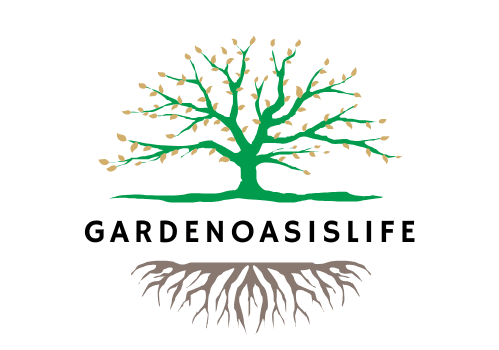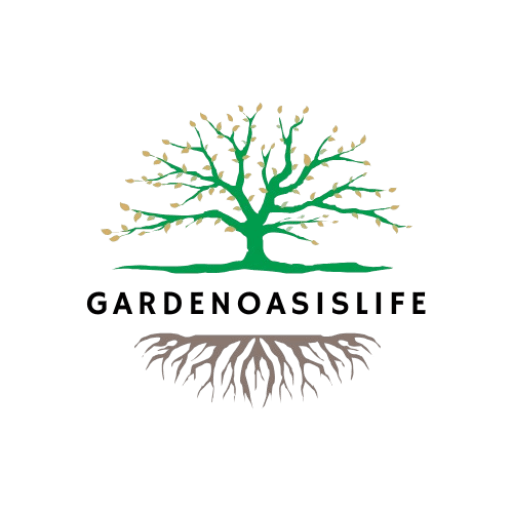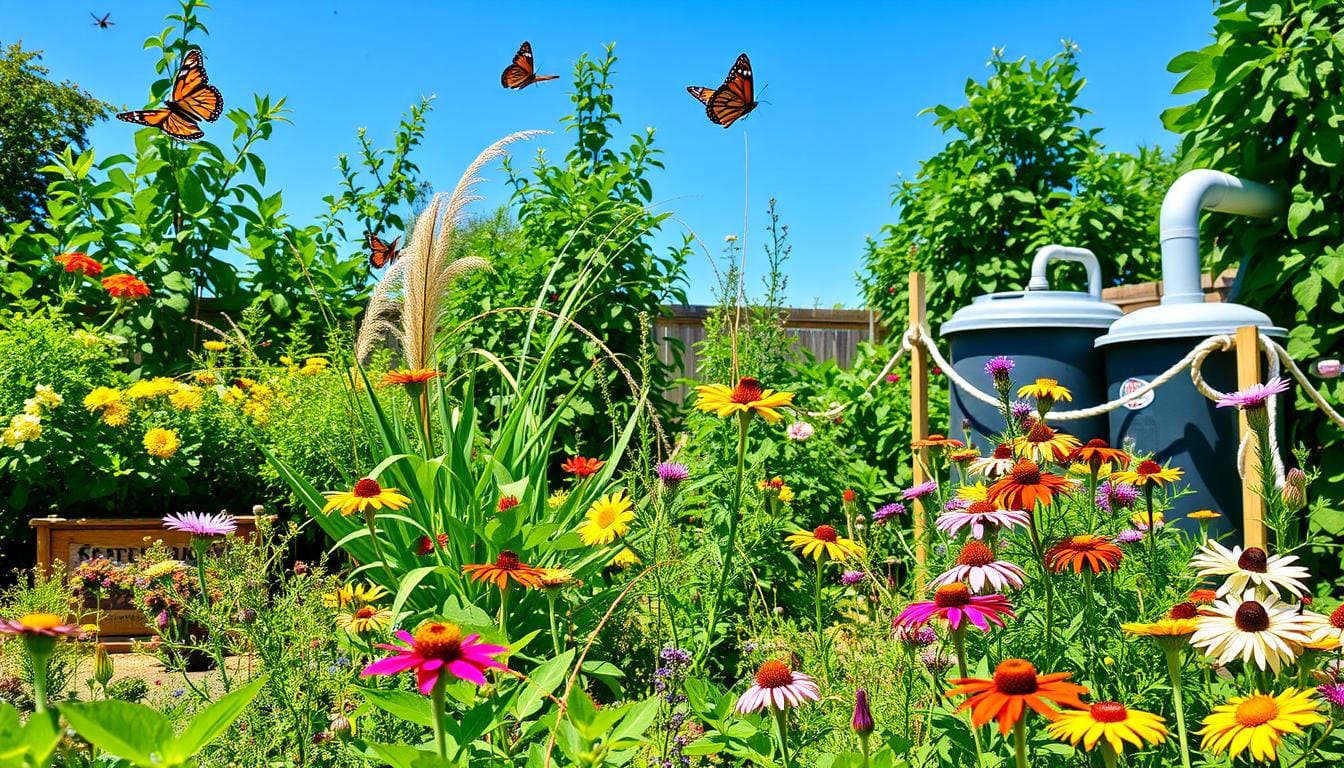Building Sustainable Gardens: Your Guide to Eco-Friendly Yards
Welcome to the world of sustainable gardening! More and more people want outdoor spaces that look good and are good for the planet. In this guide, we’ll show you how to make your yard a beautiful, eco-friendly oasis.
Key Takeaways
- Sustainable gardens focus on saving the environment and using natural resources wisely.
- Eco-friendly landscaping cuts down water use, improves soil, and boosts biodiversity.
- Using native plants and organic gardening can make a big difference.
- Good planning and design are key for a sustainable garden that’s easy to care for.
- Smart water use and natural soil care make your garden even more sustainable.
By the end of this guide, you’ll know how to turn your yard into a sustainable paradise. It will not only beautify your property but also help the environment. Let’s start exploring the magic of sustainable gardening!
Understanding the Basics of Sustainable Gardens
Creating an Organic Gardening or Eco-Friendly Landscaping space is rewarding. It benefits the environment and your personal space. A sustainable garden works in harmony, creating a thriving ecosystem.
What Makes a Garden Sustainable?
A sustainable garden uses less resources, supports biodiversity, and keeps the ecosystem balanced. Using natural processes and native plants makes the garden low-maintenance. It supports pollinators, saves water, and cuts down on chemical use.
Environmental Benefits of Eco-Friendly Gardening
- Supports local wildlife and biodiversity by providing food and shelter for native species
- Reduces the use of synthetic fertilizers and pesticides, protecting soil health and water quality
- Conserves water through the use of drought-tolerant plants and efficient irrigation methods
- Sequesters carbon and contributes to the overall climate resilience of the local environment
Core Principles of Sustainable Landscaping
- Water Conservation: Uses water-wise plants, efficient irrigation, and water harvesting to save water.
- Soil Health: Keeps soil rich and biologically active with organic matter, composting, and natural amendments.
- Biodiversity Preservation: Chooses diverse native plants for food and shelter for local wildlife.
- Ecological Harmony: Designs the garden to mimic natural ecosystems, reducing external inputs and promoting self-sustaining processes.
By following these principles, gardeners can make an Organic Gardening or Eco-Friendly Landscaping oasis. This oasis not only beautifies outdoor spaces but also helps the local environment’s health and resilience.
“A garden is a grand teacher. It teaches patience and careful watchfulness; it teaches industry and thrift; above all it teaches entire trust.”
– Gertrude Jekyll
Planning Your Eco-Friendly Garden Layout
Creating an eco-friendly garden needs careful planning. Start by checking the sun, water flow, and site conditions. This helps place plants where they’ll grow best.
Use Permaculture design to make your garden self-sustaining. It works with nature, placing plants and water sources wisely. This way, your garden can support itself.
- Do a site analysis: Look at sun, soil, and landscape to find the best spots for plants.
- Plan plant placement: Group plants by their needs, like sun or shade, to help them grow.
- Manage water: Use features like swales and drought-resistant plants to save water.
- Add biodiversity: Include native plants and flowers to attract wildlife and support a healthy ecosystem.
| Design Principle | Description | Example |
|---|---|---|
| Zone Planning | Divide the garden into zones for different uses and care levels. | Put high-care areas like vegetable beds near the house. Use outer zones for low-care native plants. |
| Stacking Functions | Use plants that serve many purposes, like food, habitat, and erosion control. | Choose a fruit tree for shade, food, and to attract pollinators. |
| Closed-Loop Systems | Make the garden cycle like nature, where waste becomes a resource. | Use compost from waste to improve soil and help plants grow. |
By planning well and using Permaculture ideas, you can make a garden that’s good for the planet. It will be a thriving oasis with little harm to the environment.
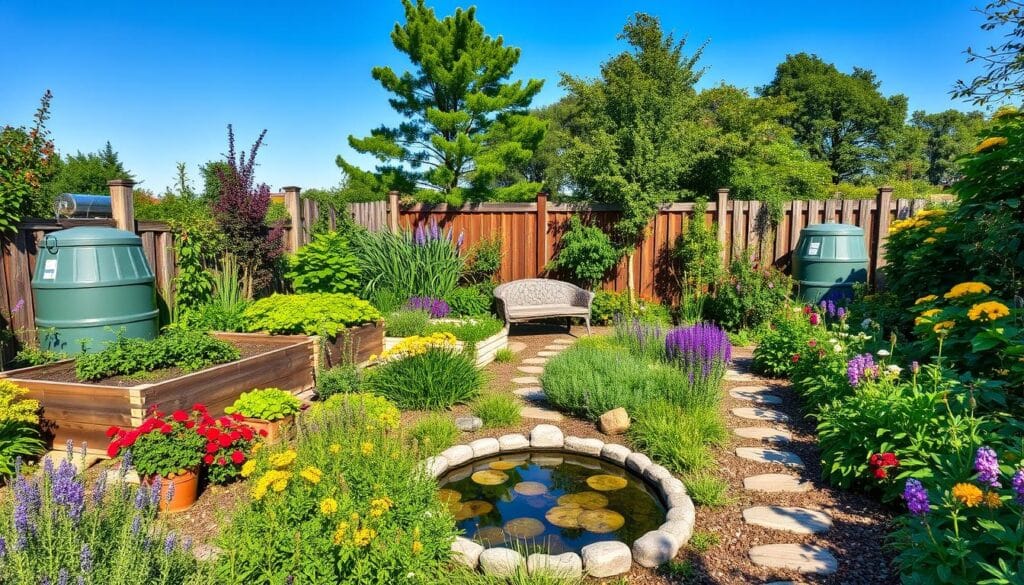
“A garden is a grand teacher. It teaches patience and careful watchfulness; it teaches industry and thrift; above all it teaches entire trust.” – Gertrude Jekyll
Essential Native Plants for Your Sustainable Garden
Sustainable gardening is about reducing our environmental impact and celebrating local ecosystems. Choosing native plants is key to creating an eco-friendly garden. These plants, which have evolved with local wildlife, offer many benefits. They can turn your outdoor space into a thriving biodiversity oasis.
Benefits of Choosing Native Species
Native plants need less water, fertilizer, and care than non-native ones. They provide food and shelter for native pollinators, birds, and wildlife. This helps preserve local biodiversity. By using native plants, you can have a sustainable, easy-to-care-for garden that supports your local ecosystem.
Top Native Plants for Different Climate Zones
- Northeastern United States: Coneflowers, Bee Balm, Serviceberry
- Southeastern United States: Blanket Flower, Blazing Star, Butterfly Bush
- Midwestern United States: Prairie Dropseed, Purple Coneflower, Swamp Milkweed
- Western United States: Sage, Penstemon, Yarrow
Creating Wildlife-Friendly Habitats
To make your garden even better, create diverse habitats for wildlife. Add bird baths, insect hotels, and brush piles for food, water, and shelter. This way, you’ll enjoy the beauty of nature and help your local ecosystem thrive.
Smart Water Conservation Techniques
Sustainable gardens need efficient water management. Using water conservation practices is key for sustainable gardens. These gardens are not just beautiful but also protect our natural resources. Techniques like harvesting rainwater and using smart irrigation systems help use less water and lessen environmental harm.
Rainwater harvesting is a smart move. It collects rain for later use in the garden. This cuts down on the need for city water and helps groundwater and local ecosystems.
Drip irrigation systems also save water. They send water straight to the roots, cutting down on evaporation and runoff.
Choosing native plants that don’t need much water is another smart choice. These plants are made for the local climate and need less water. Mulching around plants also keeps the soil moist, saving water.
- Implement rainwater harvesting systems to collect and store precipitation
- Use drip irrigation to deliver water directly to plant roots, minimizing waste
- Choose drought-tolerant, native plants that are adapted to the local climate
- Apply mulch around plants to retain soil moisture and reduce evaporation
By using these water conservation methods, gardeners can make beautiful, sustainable gardens. These gardens save water, help local wildlife, and make our environment healthier.
“Gardening is the art of incorporating nature’s bounty into our lives, and water conservation is a crucial aspect of that art. By embracing sustainable water practices, we can nurture thriving gardens that enrich both our landscapes and our environmental footprint.”
Natural Soil Management and Composting Methods
Healthy, nutrient-rich soil is key for a sustainable garden. Natural soil management and composting help gardeners feed their plants. This reduces the need for synthetic chemicals and fertilizers.
Building Healthy Soil Naturally
Organic matter is crucial for healthy soil. Adding compost, leaf litter, and natural materials improves soil structure and nutrient levels. This supports beneficial microorganisms and earthworms, making the soil even more fertile.
Creating Your Own Compost System
Composting turns waste into a valuable soil amendment. A dedicated compost bin or pile makes it easy to create nutrient-rich compost. This enriches the soil in your Organic Gardening space.
- Choose a shaded area near the garden for your compost system.
- Gather organic materials like kitchen scraps, leaves, grass clippings, and shredded paper.
- Keep a balance of “green” (nitrogen-rich) and “brown” (carbon-rich) materials for best Composting.
- Turn and aerate the compost pile regularly to speed up decomposition.
Organic Fertilizing Solutions
Organic fertilizers like bone meal, blood meal, and seaweed extracts are great for plants. They offer a slow-release, natural way to feed plants without synthetic chemicals.
| Organic Fertilizer | Nutrient Profile | Benefits |
|---|---|---|
| Bone Meal | High in phosphorus | Supports root and flower development |
| Blood Meal | High in nitrogen | Promotes lush foliage growth |
| Seaweed Extract | Contains trace minerals | Enhances plant resilience and disease resistance |
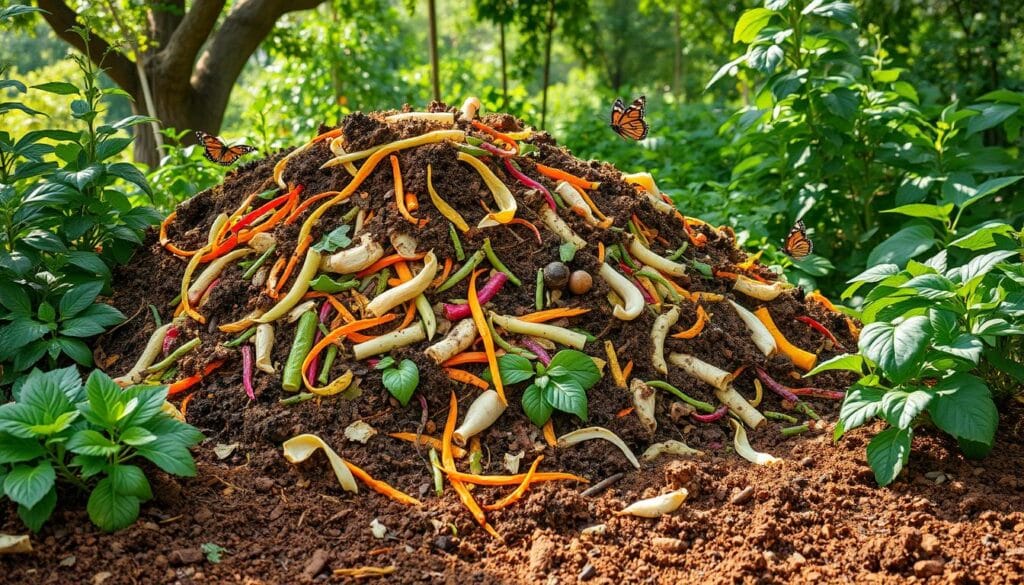
Using natural soil management and Composting techniques creates a thriving ecosystem in your Organic Gardening space. This ensures your plants stay healthy and productive for years.
Implementing Permaculture Design Principles
Permaculture is a way to garden that makes your outdoor space work like nature. It’s all about creating a system that’s good for the planet and gives you lots of food. This approach helps your garden grow strong and healthy, making it better for you and the environment.
At the heart of permaculture is the idea of zones. You divide your garden into areas based on how much work they need. Zone 1 is closest to your house, where you grow food you use a lot. Zone 2 is for things you don’t use as often, like a small orchard. Zone 3 is for big, easy-to-care-for areas for growing food or raising animals.
Understanding sectors is also key. It’s about how energy, water, and other resources move through your garden. By knowing these patterns, you can place plants and features to use resources well. This helps your garden grow strong and waste less.
The idea of stacking functions means using each element for more than one thing. For example, a fruit tree gives you food, shade, and a home for insects. You can even grow vines on it for more food.
By using permaculture, you can make a sustainable garden that’s like a little piece of nature. It’s good for the planet and gives you lots of benefits. With careful planning, your garden can be a green, thriving space that’s good for you and the earth.

Urban Farming and Small Space Solutions
In today’s cities, finding space for a garden can be tough. But, Urban Farming and new ways to garden in small spaces have changed this. Now, city folks can have Sustainable Gardens in tiny areas.
Vertical Gardening Techniques
Vertical gardening is a great way to make the most of your space. Use walls, trellises, and more to grow plants like greens and vines. It saves space and makes your garden look amazing.
Container Gardening for Limited Spaces
If you have very little space, container gardening is perfect. Choose plants that grow well in small spaces and arrange your containers creatively. This way, you can have a Sustainable Garden on balconies, patios, or small porches. It lets you tailor your garden to your liking.
Maximizing Urban Garden Productivity
- Try succession planting to get more from your space.
- Use companion planting to help your plants grow better.
- Use vertical spaces like trellises and hanging baskets.
- Keep your soil rich with compost and nutrients.
By following Urban Farming and Sustainable Gardens ideas, city people can turn small areas into green spaces. With some creativity and a focus on sustainability, you can grow your own food and help the environment in the city.
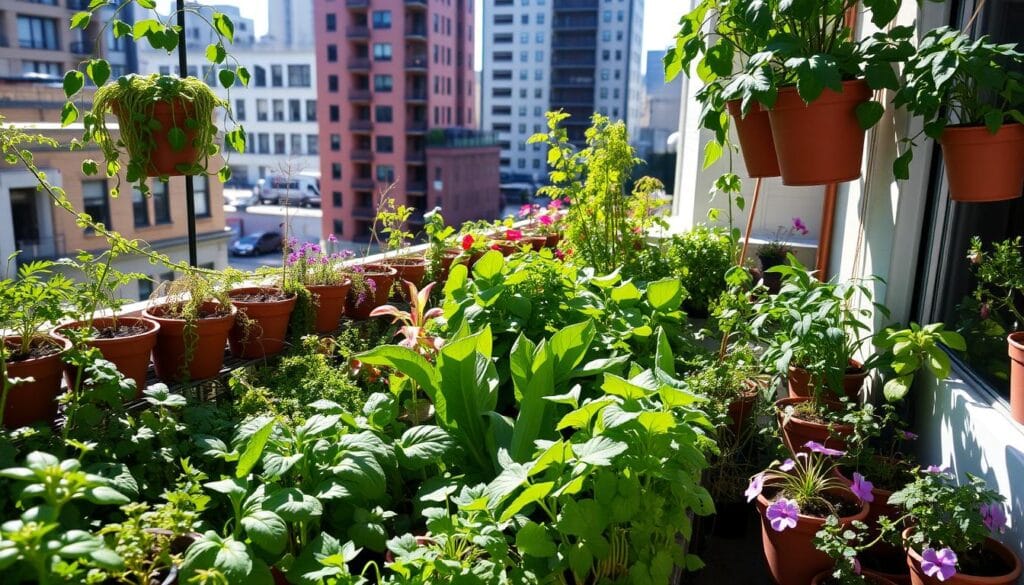
Maintaining Biodiversity in Your Garden
Creating a diverse garden is key to keeping nature in balance. By promoting biodiversity, you make a lively space for many plants and animals. This includes helpful insects and birds that migrate.
Using native plants in your garden is a smart move. They’ve grown with local wildlife, offering food and shelter. Native plants draw in bees, butterflies, and hummingbirds, which are crucial for your garden’s health.
- Choose native plants that bloom at different times to feed pollinators all season.
- Offer different homes, like dead wood and water, for various animals.
- Use fewer pesticides and herbicides to protect the ecosystem and its helpers.
Adopting sustainable gardening practices turns your garden into a thriving spot. It supports biodiversity and helps the local environment.
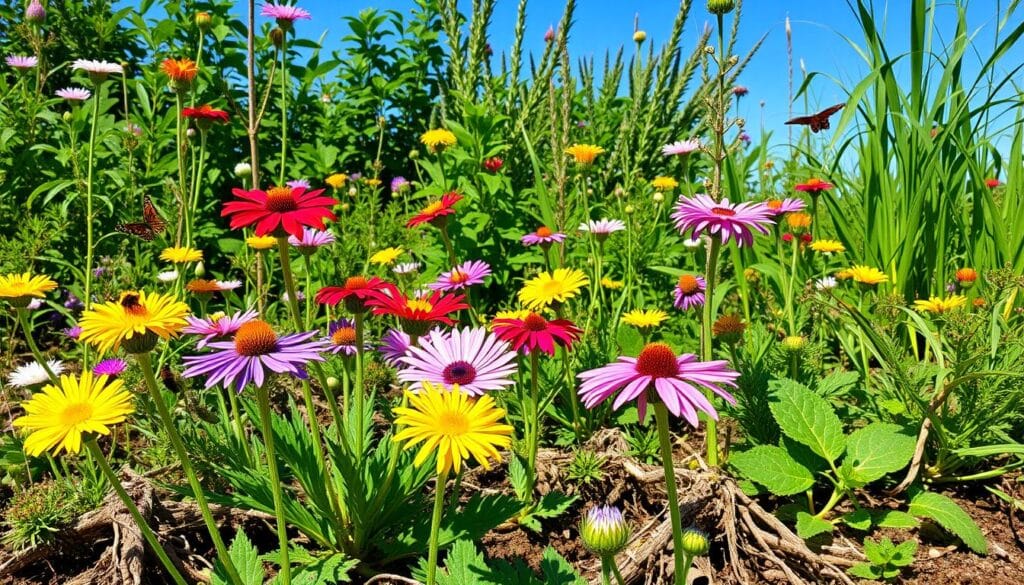
“A garden that supports biodiversity is a living, breathing, ever-changing masterpiece, where the beauty lies in the intricate web of life that flourishes within.”
Conclusion
Sustainable gardening is key to making eco-friendly yards. These yards are good for the environment and make our outdoor spaces more beautiful and productive. We’ve talked about planning your garden and using permaculture principles to make your landscape thrive.
Using native plants, saving water, and taking care of soil naturally helps. This creates a garden that supports local wildlife and reduces carbon footprint. It also makes a peaceful and nourishing space at home.
Every small step in sustainable gardening helps a lot. It makes our ecosystem healthier and more resilient. So, let’s start using these Sustainable Gardens and Eco-Friendly Landscaping ideas. Together, we can create a greener future for our communities and the planet.
